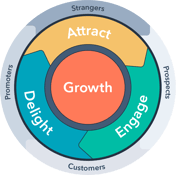As a marketer, you’ve probably heard the word “flywheel” a lot. It gets thrown around quite a bit in blogs and social media posts, and if you’re a HubSpot user you’ve probably taken some training on thinking in terms of the flywheel methodology.
But is it the right approach for you and your business? You and your team are crazy busy with marketing campaigns like writing content, creating premium downloads, building email nurture funnels, and trying to bring in as many warm leads as possible for the Sales team.
You’re probably under a lot of pressure to perform – and if you’re struggling to hit your goals, then it’s probably because you’re not focusing on the right things.
Let’s break it down.
The Problem with the Flywheel
Flywheels are actually not HubSpot-specific, but it’s something that they adopted for their own inbound marketing a few years ago and they teach it on their website and in their courses on HubSpot Academy.
It looks something like this:

(image courtesy of HubSpot)
That orange dot in the middle is your customer, and Attract, Engage, and Delight are the three main lifecycle stages your customer should go through with you. Everything centers around the customer and if you do it right, you’ll be able to bring in a steady stream of new customers who are happy with your product or services and want to keep buying from you.
It’s been an effective approach because, unlike thinking from a “funnel” perspective, the flywheel takes the focus away from being transactional and more about delivering an incredible customer experience that increases the lifetime value (LTV) of your customer instead of just a one-time transaction.
The flywheel sounds great! So what’s the problem?
There are a few places where the flywheel methodology falls short, and this is where we see marketers spin their tires without getting results.
If you look at the graphic, the flywheel starts with attracting the right kind of audience to your company. Sounds natural, right?
The problem is that it’s not where you’re going to have the biggest impact as a marketer. In fact, we see this all the time. People come to us saying, “We’re getting good web traffic, we’re generating lots of leads, we’re seeing lots of traction for keyword rankings – and yet, our business isn’t growing. What gives?”
Does this sound familiar?
So many marketers get tied up in the attract phase and they’re not thinking about where they can actually have the biggest impact: revenue.
The Revenue-First Approach
Instead of focusing on the top of the flywheel and attracting the right audience, instead focus on the bottom of the flywheel. The transition between engage and delight is where leads become customers – and if you can nail that part down, you’ll shatter your marketing goals.
This may sound painfully obvious, but we’re going to say it anyway: your business exists to make money.
Duh, right? And the only way to move your business forward is to generate more sales.
Yet, so many marketing departments don’t have that mindset. They’re thinking about writing blog content, creating clever graphics, and which hashtags to use on social media.
Stop focusing on writing buyer personas, doing keyword research, performing content audits, and everything else that just seems to constantly be stacking up on your plate.
Instead, shift your time and efforts into what’s actually going to have an impact on revenue.
One of the best ways we recommend doing this, and it’s something we do both for ourselves as an agency and recommend to almost all of our clients, is to build a webinar funnel that generates sales opportunities.
Build a machine where you can say, “Okay, I know that if I get 100 people into this funnel, I will get 2 customers.” That’s an average, which gives you the tools to set target goals for your marketing team. If you need 20 customers this quarter, then you need to get 1,000 leads into that machine.
But the key point is to build that machine first – then go back to the attract phase and bring people into your funnel.
And that’s where flipping the flywheel comes in, and what so many marketers get wrong.
If you interviewed me for a marketing position today, I would not even talk about content or SEO. I’m going to talk about the fastest way to generate opportunities for your sales team because that’s how I can prove my value to the company.
Of course, SEO, blogging, social media, keywords, emails – all those things are still super important and NEED to have their place in any marketing strategy. However, many of them take six to nine months to deliver results. Can you wait that long to prove your value?
If your boss says, “Hey, I need you to generate 10 sales calls this week,” what are you going to do? Write a couple of blog posts? Work with your designer on a new infographic? Maybe check the bounce rate on your website?
No, you’re going to want to create a sales machine that’s built to deliver quality leads to the Sales team.
And the beautiful thing is, once that machine is built, then it just becomes a numbers game. It’s about volume. If you know what your averages are, then you know how many people you need to get into the machine in order to hit your goals.
That’s where the awareness stuff comes back into play. At that point, you can focus on SEO, keywords, blog posts, social media, CTAs, ads – all the levers that you need to pull to get as many qualified people into that funnel as possible.



